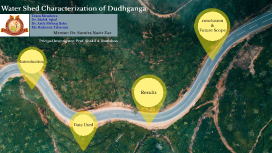presentation winter school KU
Transcript: Water Shed Characterization of Dudhganga Team Members: Dr. Mohd. Iqbal Dr. Asifa Mehraj Baba Ms. Ruheena Tabasum Mentor: Dr. Sumira Nazir Zaz Pricipal Investigator: Prof. Shakil A. Romshoo Introduction Introduction A watershed is an area of land that drains or “sheds” water into a specific waterbody. Since the watershed concept has gained momentum and presently forms the basis of using natural resources data. Watershed refers to the area of land where all the water drains to a central point such as lake, river or stream. Why Watershed Charactirization: To access land Degradation such as Erosion, Vegetation Change and Wetland Loss. Used for effective planning and optimum development of land and water resources These cahratiristics provide the valuable Information for Identifying Causes and Consequences of Land degradation and thus Outlining Potential; Hazard areas and Designing Remideal Measures. Charactiristics under study Charactiristics under Investigation : An attempt is made to evaluate the physical characteristics of the Dudhganga catchment Kashmir Valley (J&K), India which includes: land use land cover Slope Aspect Relief Drainage pattern Study Area more than 17 Watersheds in kashmir Valley Dudhganga catchment of Kashmir valley Area: 640 sqkm Duudgagha falls in the Southwest of the kashmir Valley Data used: Landsat 8,9 Satellite Data of Duudhganga Data Used The physical Charactitristics, which are important from the hydrological studies point of view, include the aspect, slope, drainage, Elevation and Land Use land Cover can be systematically derived using Geographic Information System (GIS) technique. Results Drainage Fig.2 Drainage Network of Dudhganga Catchment, Kashmir valley, India Slope Table 1 Slope of Dudhganga Catchment, Kashmir valley, India Table 2 Slope characteristics of the Dudhganga catchment Land use land cover Fig.5 Land use/land cover of Dudhganga Catchment, Kashmir valley, India Table 4 Land use/Land cover characteristics of the Dudhganga catchment Aspect Fig.6 Aspect of Dudhganga Catchment, Kashmir valley, India Table 5 Aspect characteristics of the Dudhganga catchment Elevation Fig.4 Elevation of Dudhganga Catchment, Kashmir valley, India Table 3 Elevation characteristics of the Dudhganga catchment Future Work: Classification of Land Use Land Cover Mapping can be done using Deep Learning Techniques. These Raster Layers can be used for Simulation Modelling like dicepering groud water potential and thus the generation of Flood Risk Map. Conculsion The main aim of the research project was to evaluate the charactiristics of Duudganga Catchment area which includes Slope, Aspect, Elevation, Drainage and Land Use land Cover. Quantitative analysis of geomorphological parameters of the Dudhganga catchment is carried out in order to Identifying Causes and Consequences of Land degradation/watershed degradation and to suggest the remedial measures. conclusion & Future Scope

















